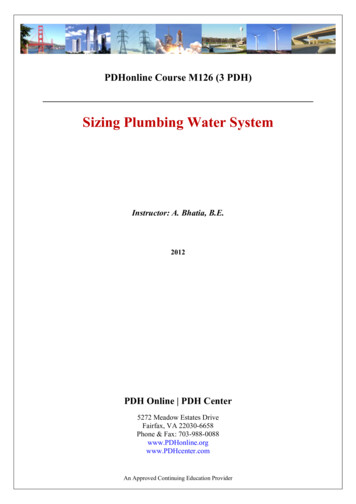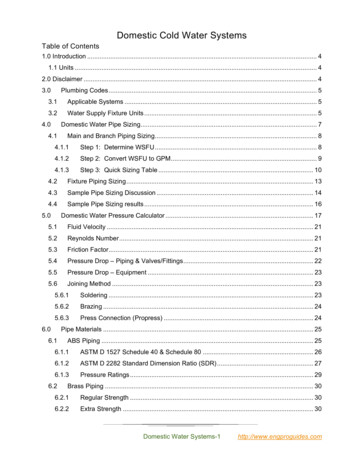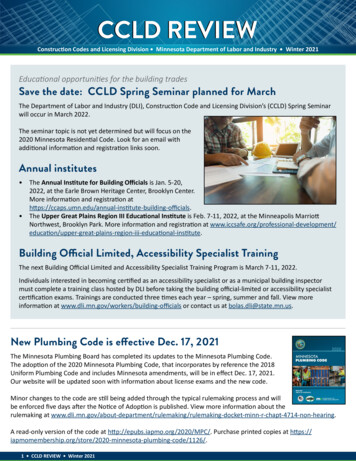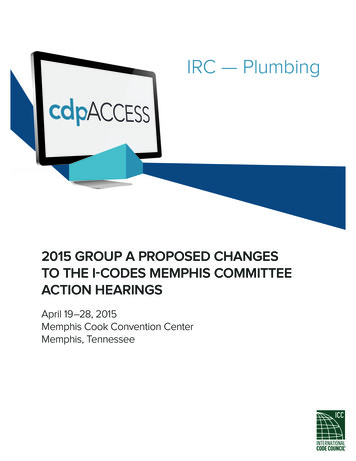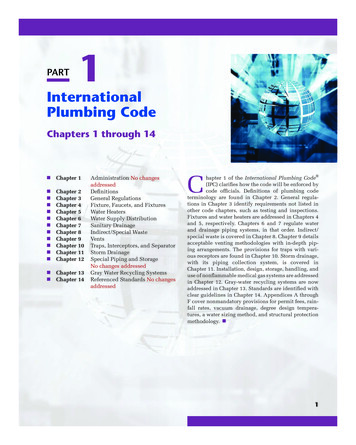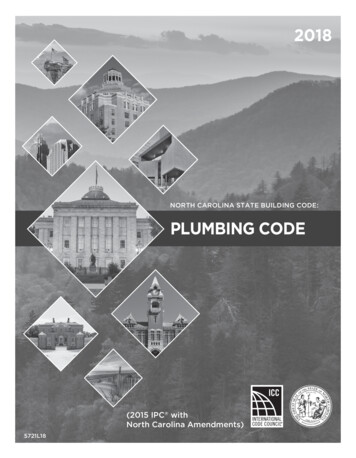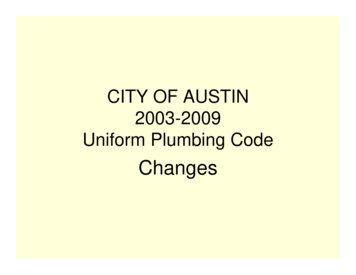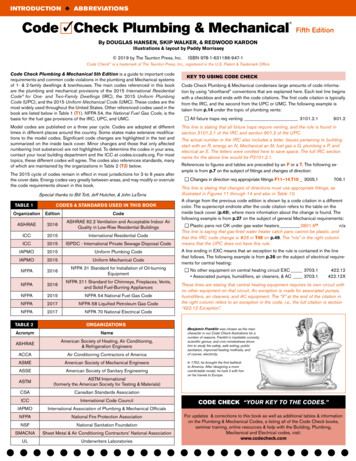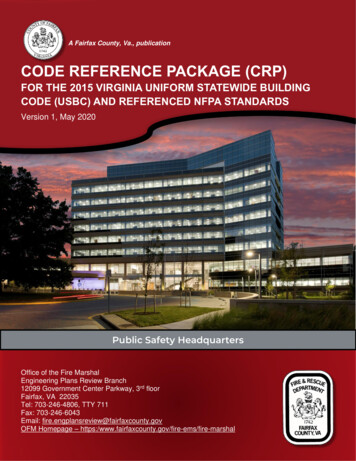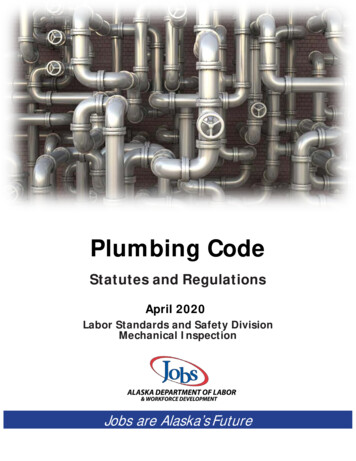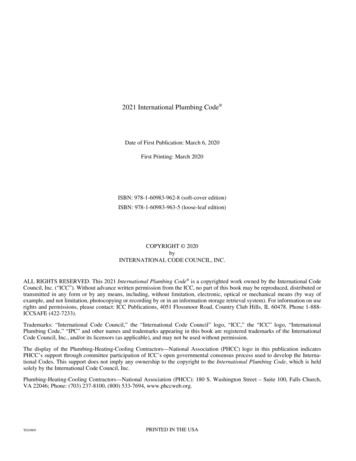
Transcription
2021 International Plumbing Code Date of First Publication: March 6, 2020First Printing: March 2020ISBN: 978-1-60983-962-8 (soft-cover edition)ISBN: 978-1-60983-963-5 (loose-leaf edition)COPYRIGHT 2020byINTERNATIONAL CODE COUNCIL, INC.ALL RIGHTS RESERVED. This 2021 International Plumbing Code is a copyrighted work owned by the International CodeCouncil, Inc. (“ICC”). Without advance written permission from the ICC, no part of this book may be reproduced, distributed ortransmitted in any form or by any means, including, without limitation, electronic, optical or mechanical means (by way ofexample, and not limitation, photocopying or recording by or in an information storage retrieval system). For information on userights and permissions, please contact: ICC Publications, 4051 Flossmoor Road, Country Club Hills, IL 60478. Phone 1-888ICCSAFE (422-7233).Trademarks: “International Code Council,” the “International Code Council” logo, “ICC,” the “ICC” logo, “InternationalPlumbing Code,” “IPC” and other names and trademarks appearing in this book are registered trademarks of the InternationalCode Council, Inc., and/or its licensors (as applicable), and may not be used without permission.The display of the Plumbing-Heating-Cooling Contractors—National Association (PHCC) logo in this publication indicatesPHCC’s support through committee participation of ICC’s open governmental consensus process used to develop the International Codes. This support does not imply any ownership to the copyright to the International Plumbing Code, which is heldsolely by the International Code Council, Inc.Plumbing-Heating-Cooling Contractors—National Association (PHCC): 180 S. Washington Street – Suite 100, Falls Church,VA 22046; Phone: (703) 237-8100, (800) 533-7694, www.phccweb.org.T024869PRINTED IN THE USA
PREFACEIntroductionThe International Plumbing Code (IPC ) establishes minimum requirements for plumbing systemsusing prescriptive and performance-related provisions. It is founded on broad-based principles thatmake possible the use of new materials and new plumbing designs. This 2021 edition is fully compatible with all of the International Codes (I-Codes ) published by the International Code Council (ICC ),including the International Building Code , International Energy Conservation Code , InternationalExisting Building Code , International Fire Code , International Fuel Gas Code , International GreenConstruction Code , International Mechanical Code , International Private Sewage Disposal Code ,International Property Maintenance Code , International Residential Code , International SwimmingPool and Spa Code , International Wildland-Urban Interface Code , International Zoning Code andInternational Code Council Performance Code .The I-Codes, including this International Plumbing Code, are used in a variety of ways in both thepublic and private sectors. Most industry professionals are familiar with the I-Codes as the basis oflaws and regulations in communities across the US and in other countries. However, the impact of thecodes extends well beyond the regulatory arena, as they are used in a variety of nonregulatory settings, including: Voluntary compliance programs such as those promoting sustainability, energy efficiency anddisaster resistance. The insurance industry, to estimate and manage risk, and as a tool in underwriting and ratedecisions. Certification and credentialing of individuals involved in the fields of building design, construction and safety. Certification of building and construction-related products. US federal agencies, to guide construction in an array of government-owned properties. Facilities management. “Best practices” benchmarks for designers and builders, including those who are engaged inprojects in jurisdictions that do not have a formal regulatory system or a governmentalenforcement mechanism. College, university and professional school textbooks and curricula. Reference works related to building design and construction.In addition to the codes themselves, the code development process brings together building professionals on a regular basis. It provides an international forum for discussion and deliberation aboutbuilding design, construction methods, safety, performance requirements, technological advancesand innovative products.DevelopmentThis 2021 edition presents the code as originally issued, with changes reflected in the 2003 through2018 editions and with further changes approved by the ICC Code Development Process through 2019.A new edition such as this is promulgated every 3 years.This code is founded on principles intended to establish provisions consistent with the scope of aplumbing code that adequately protects public health, safety and welfare; provisions that do notunnecessarily increase construction costs; provisions that do not restrict the use of new materials,products or methods of construction; and provisions that do not give preferential treatment to particular types or classes of materials, products or methods of construction.2021 INTERNATIONAL PLUMBING CODE iii
MaintenanceThe International Plumbing Code is kept up to date through the review of proposed changes submittedby code enforcement officials, industry representatives, design professionals and other interested parties. Proposed changes are carefully considered through an open code development process in whichall interested and affected parties may participate.The ICC Code Development Process reflects principles of openness, transparency, balance, due process and consensus, the principles embodied in OMB Circular A-119, which governs the federal government’s use of private-sector standards. The ICC process is open to anyone; there is no cost toparticipate, and people can participate without travel cost through the ICC’s cloud-based app, cdpAccess . A broad cross-section of interests are represented in the ICC Code Development Process. Thecodes, which are updated regularly, include safeguards that allow for emergency action whenrequired for health and safety reasons.In order to ensure that organizations with a direct and material interest in the codes have a voice inthe process, the ICC has developed partnerships with key industry segments that support the ICC’simportant public safety mission. Some code development committee members were nominated bythe following industry partners and approved by the ICC Board: American Institute of Architects (AIA) American Society of Plumbing Engineers (ASPE) National Association of Home Builders (NAHB) Plumbing Heating and Cooling Contractors (PHCC)The code development committees evaluate and make recommendations regarding proposedchanges to the codes. Their recommendations are then subject to public comment and council-widevotes. The ICC’s governmental members—public safety officials who have no financial or businessinterest in the outcome—cast the final votes on proposed changes.The contents of this work are subject to change through the code development cycles and by anygovernmental entity that enacts the code into law. For more information regarding the code development process, contact the Codes and Standards Development Department of the International CodeCouncil.While the I-Code development procedure is thorough and comprehensive, the ICC, its membersand those participating in the development of the codes disclaim any liability resulting from the publication or use of the I-Codes, or from compliance or noncompliance with their provisions. The ICC doesnot have the power or authority to police or enforce compliance with the contents of this code.Code Development Committee Responsibilities(Letter Designations in Front of Section Numbers)In each code development cycle, proposed changes to the code are considered at the CommitteeAction Hearings by the International Plumbing Code Development Committee, whose action constitutes a recommendation to the voting membership for final action on the proposed change. Proposedchanges to a code section that has a number beginning with a letter in brackets are considered by adifferent code development committee. For example, proposed changes to code sections that have[BS] in front of them (e.g., [BS] 309.2) are considered by the IBC—Structural Code Development Committee at the code development hearings.The bracketed letter designations for committees responsible for portions of this code are as follows:[A] Administrative Code Development Committee[BE] IBC—Egress Code Development Committee[BG] IBC—General Code Development Committee[BS] IBC—Structural Code Development Committeeiv2021 INTERNATIONAL PLUMBING CODE
[E] International Energy Conservation Code Development Committee[F] International Fire Code Development Committee[M] International Mechanical Code Development CommitteeFor the development of the 2024 edition of the I-Codes, there will be two groups of code development committees and they will meet in separate years, as shown in the following Code DevelopmentHearings Table).Code change proposals submitted for code sections that have a letter designation in front of themwill be heard by the respective committee responsible for such code sections. Because different committees hold Committee Action Hearings in different years, proposals for the IPC will be heard by committees in both the 2021 (Group A) and the 2022 (Group B) code development cycles.For example, every section of Chapter 1 of this code is designated as the responsibility of theAdministrative Code Development Committee, which is part of the Group B portion of the hearings.This committee will hold its Committee Action Hearings in 2022 to consider code change proposals forChapter 1 of all I-Codes except the International Energy Conservation Code, International ResidentialCode and International Green Construction Code. Therefore, any proposals received for Chapter 1 ofthis code will be assigned to the Administrative Code Development Committee for consideration in2022.It is very important that anyone submitting code change proposals understands which code development committee is responsible for the section of the code that is the subject of the code changeproposal. For further information on the Code Development Committee responsibilities, please visitthe ICC website at e.CODE DEVELOPMENT HEARINGSGroup A Codes(Heard in 2021, Code Change ProposalsDeadline: January 11, 2021)International Building Code– Egress (Chapters 10, 11, Appendix E)– Fire Safety (Chapters 7, 8, 9, 14, 26)– General (Chapters 2–6, 12, 27–33,Appendices A, B, C, D, K, N)International Fire CodeGroup B Codes(Heard in 2022, Code Change ProposalsDeadline: January 10, 2022)Administrative Provisions (Chapter 1 of all codesexcept IECC, IRC and IgCC, administrativeupdates to currently referenced standards, anddesignated definitions)International Building Code– Structural (Chapters 15–25,Appendices F, G, H, I, J, L, M)International Fuel Gas CodeInternational Existing Building CodeInternational Mechanical CodeInternational Energy Conservation Code—CommercialInternational Plumbing CodeInternational Energy Conservation Code—Residential– IECC—Residential– IRC—Energy (Chapter 11)International Property Maintenance CodeInternational Green Construction Code(Chapter 1)International Private Sewage Disposal CodeInternational Residential Code– IRC—Building (Chapters 1–10,Appendices E, F, H, J, K, L, M, O, Q, R, S, T)(continued)2021 INTERNATIONAL PLUMBING CODE v
CODE DEVELOPMENT HEARINGS—continuedGroup A Codes(Heard in 2021, Code Change ProposalsDeadline: January 11, 2021)Group B Codes(Heard in 2022, Code Change ProposalsDeadline: January 10, 2022)International Residential Code– IRC—Mechanical (Chapters 12–23)– IRC—Plumbing (Chapters 25–33,Appendices G, I, N, P)International Swimming Pool and Spa CodeInternational Wildland-Urban Interface CodeInternational Zoning CodeNote: Proposed changes to the ICC Performance Code will be heard by the code development committee noted in brackets [ ] in the text of the ICC Performance Code .Marginal MarkingsSolid vertical lines in the margins within the body of the code indicate a technical change from therequirements of the 2018 edition. Deletion indicators in the form of an arrow ( ) are provided in themargin where an entire section, paragraph, exception or table has been deleted or an item in a list ofitems or a table has been deleted.A single asterisk [*] placed in the margin indicates that text or a table has been relocated within thecode. A double asterisk [**] placed in the margin indicates that the text or table immediately followingit has been relocated there from elsewhere in the code. The following table indicates such relocationsin the 2021 edition of the International Plumbing Code.RELOCATIONS2021 LOCATION2018 .6 and 106.6.1110106.3.1 and 106.5.6111107.5 and 107.5.1112107.6 and 109.2.4(continued)vi2021 INTERNATIONAL PLUMBING CODE
RELOCATIONS—continued2021 LOCATION2018 101.7.2109.6.2F101.8109.7Coordination of the International CodesThe coordination of technical provisions is one of the strengths of the ICC family of model codes. Thecodes can be used as a complete set of complementary documents, which will provide users with fullintegration and coordination of technical provisions. Individual codes can also be used in subsets or asstand-alone documents. To make sure that each individual code is as complete as possible, some technical provisions that are relevant to more than one subject area are duplicated in some of the modelcodes. This allows users maximum flexibility in their application of the I-Codes.Italicized TermsWords and terms defined in Chapter 2, Definitions, are italicized where they appear in code text andthe Chapter 2 definition applies. Where such words and terms are not italicized, common-use definitions apply. The words and terms selected have code-specific definitions that the user should readcarefully to facilitate better understanding of the code.AdoptionThe International Code Council maintains a copyright in all of its codes and standards. Maintainingcopyright allows the ICC to fund its mission through sales of books, in both print and electronic formats. The ICC welcomes adoption of its codes by jurisdictions that recognize and acknowledge theICC’s copyright in the code, and further acknowledge the substantial shared value of the public/privatepartnership for code development between jurisdictions and the ICC.The ICC also recognizes the need for jurisdictions to make laws available to the public. All I-Codesand I-Standards, along with the laws of many jurisdictions, are available for free in a nondownloadableform on the ICC’s website. Jurisdictions should contact the ICC at adoptions@iccsafe.org to learn howto adopt and distribute laws based on the International Plumbing Code in a manner that provides necessary access, while maintaining the ICC’s copyright.To facilitate adoption, several sections of this code contain blanks for fill-in information that needsto be supplied by the adopting jurisdiction as part of the adoption legislation. For this code, please see:Section 101.1. Insert: [NAME OF JURISDICTION]Section 103.1. Insert: [NAME OF DEPARTMENT]Section 115.4. Insert: [OFFENSE, DOLLAR AMOUNT, NUMBER OF DAYS]Section 305.4.1. Insert: [NUMBER OF INCHES IN TWO LOCATIONS]Section 903.1.1. Insert: [NUMBER OF INCHES]2021 INTERNATIONAL PLUMBING CODE vii
Effective use of the International Plumbing CodeThe International Plumbing Code (IPC) is a model code that regulates the design and installation ofplumbing systems including the plumbing fixtures in all types of buildings except for detached oneand two-family dwellings and townhouses that are not more than three stories above grade in height.The regulations for plumbing systems in one- and two-family dwellings and townhouses are coveredby Chapters 25 through 33 of the International Residential Code (IRC). The IPC addresses generalplumbing regulations, fixture requirements, water heater installations and systems for water distribution, sanitary drainage, special wastes, venting, storm drainage and medical gases. The IPC does notaddress fuel gas piping systems as those systems are covered by the International Fuel Gas Code(IFGC). The IPC also does not regulate swimming pool piping systems, process piping systems, or utility-owned piping and systems. The purpose of the IPC is to the establish the minimum acceptable levelof safety to protect life and property from the potential dangers associated with supplying potablewater to plumbing fixtures and outlets and the conveyance of bacteria-laden wastewater from fixtures.The IPC is primarily a specification-oriented (prescriptive) code with some performance-orientedtext. For example, Section 405.1 is a performance statement but Chapter 6 contains the prescriptiverequirements that will cause Section 405.1 to be satisfied.Where a building contains plumbing fixtures, those fixtures requiring water must be provided withan adequate supply of water for proper operation. The number of required plumbing fixtures for abuilding is specified by this code and is based upon the anticipated maximum number of occupants forthe building and the type of building occupancy. This code provides prescriptive criteria for sizing piping systems connected to those fixtures. Through the use of code-approved materials and the installation requirements specified in this code, plumbing systems will perform their intended function overthe life of the building. In summary, the IPC sets forth the minimum requirements for providing safewater to a building as well as a safe manner in which liquidborne wastes are carried away from a building.viii2021 INTERNATIONAL PLUMBING CODE
ARRANGEMENT AND FORMAT OF THE 2021 IPCThe format of the IPC allows each chapter to be devoted to a particular subject with the exception ofChapter 3, which contains general subject matters that are not extensive enough to warrant their ownindependent chapter.The following table lists those subjects. The ensuing chapter-by-chapter synopsis details the scopeand intent of the provisions of the International Plumbing Code.CHAPTER TOPICSChapters1–23456789101112131415Appendices A–FResource ASubjectsAdministration and DefinitionsGeneral RegulationsFixtures, Faucets and Fixture FittingsWater HeatersWater Supply and DistributionSanitary DrainageIndirect/Special WasteVentsTraps, Interceptors and SeparatorsStorm DrainageSpecial Piping (Medical Gas)Nonpotable Water SystemsSubsurface Graywater Soil AbsorptionReferenced StandardsAppendicesPlumbing Provisions Excerpted from ICC A117.1–2017Chapter 1 Scope and AdministrationChapter 1 contains provisions for the application, enforcement and administration of subsequentrequirements of the code. In addition to establishing the scope of the code, Chapter 1 identifies whichbuildings and structures come under its purview. Chapter 1 is largely concerned with maintaining “dueprocess of law” in enforcing the requirements contained in the body of this code. Only through carefulobservation of the administrative provisions can the code official reasonably expect to demonstratethat “equal protection under the law” has been provided.Chapter 2 DefinitionsChapter 2 is the repository of the definitions of terms used in the body of the code. Codes are technical documents and every word, term and punctuation mark can impact the meaning of the code textand the intended results. The code often uses terms that have a unique meaning in the code and thecode meaning can differ substantially from the ordinarily understood meaning of the term as usedoutside of the code.The terms defined in Chapter 2 are deemed to be of prime importance in establishing the meaningand intent of the code text that uses the terms. The user of the code should be familiar with and consult this chapter because the definitions are essential to the correct interpretation of the code andbecause the user may not be aware that a term is defined.Where understanding of a term’s definition is especially key to or necessary for understanding of aparticular code provision, the term is shown in italics. This is true only for those terms that have ameaning that is unique to the code. In other words, the generally understood meaning of a term orphrase might not be sufficient or consistent with the meaning prescribed by the code; therefore, it isessential that the code-defined meaning be known.Guidance regarding tense, gender and plurality of defined terms as well as guidance regardingterms not defined in this code is provided.2021 INTERNATIONAL PLUMBING CODE ix
Chapter 3 General RegulationsThe content of Chapter 3 is often referred to as “miscellaneous,” rather than general regulations. Thisis the only chapter in the code whose requirements do not interrelate. If a requirement cannot belocated in another chapter, it should be located in this chapter. Chapter 3 contains safety requirements for the installation of plumbing and nonplumbing requirements for all types of fixtures. Thischapter also has requirements for the identification of pipe, pipe fittings, traps, fixtures, materials anddevices used in plumbing systems.The safety requirements of this chapter provide protection for the building’s structural members,as well as prevent undue stress and strain on pipes. The building’s structural stability is protected bythe regulations for cutting and notching of structural members. Additional protection for the buildingoccupants includes requirements to maintain the plumbing in a safe and sanitary condition, as well asprivacy for those occupants.Chapter 4 Fixtures, Faucets and Fixture FittingsChapter 4 regulates the minimum number of plumbing fixtures that must be provided for every typeof building. This chapter also regulates the quality of fixtures and faucets by requiring those items tocomply with nationally recognized standards. Because fixtures must be properly installed so that theyare usable by the occupants of the building, this chapter contains the requirements for the installationof fixtures. Because the requirements for the number of plumbing fixtures affects the design of abuilding, Chapter 29 of the International Building Code (IBC) includes, verbatim, many of the requirements listed in Chapter 4 of this code.Chapter 5 Water HeatersChapter 5 regulates the design, approval and installation of water heaters and related safety devices.The intent is to minimize the hazards associated with the installation and operation of water heaters.Although this code does not regulate the size of a water heater, it does regulate all other aspects ofthe water heater installation, such as temperature and pressure relief valves, safety drip pans, installation and connections. Where a water heater also supplies water for space heating, this chapter regulates the maximum water temperature supplied to the water distribution system.Chapter 6 Water Supply and DistributionChapter 6 regulates the supply of potable water from both public and individual sources to every fixture and outlet so that it remains potable and uncontaminated. Chapter 6 also regulates the design ofthe water distribution system, which will allow fixtures to function properly and help prevent backflowconditions. The unique requirements of the water supply for health care facilities are addressed separately. It is critical that the potable water supply system remain free of actual or potential sanitary hazards by providing protection against backflow.Chapter 7 Sanitary DrainageThe purpose of Chapter 7 is to regulate the materials, design and installation of sanitary drainage piping systems and connections made to the system. The intent is to design and install sanitary drainagesystems that will function reliably, that are neither undersized nor oversized and that are constructedfrom materials, fittings and connections as prescribed herein. This chapter addresses the proper use offittings for directing the flow into and within the sanitary drain piping system. Materials and provisionsnecessary for servicing the drainage system are also included in this chapter.Chapter 8 Indirect/Special WasteChapter 8 regulates drainage installations that require an indirect connection to the sanitary drainagesystem. Fixtures and plumbing appliances, such as those associated with food preparation or handling,x2021 INTERNATIONAL PLUMBING CODE
health care facilities and potable liquids, must be protected from contamination that can result fromconnection to the drainage system. An indirect connection prevents sewage from backing up into a fixture or appliance, thus providing protection against potential health hazards. The chapter also regulates special wastes containing hazardous chemicals. Special waste must be treated to prevent anydamage to the sanitary drainage piping and to protect the sewage treatment processes.Chapter 9 VentsChapter 9 covers the requirements for vents and venting. Knowing why venting is required makes iteasier to understand the intent of this chapter. Venting protects every trap against the loss of its seal.Provisions set forth in this chapter are geared toward limiting the pressure differentials in the drainagesystem to a maximum of 1 inch of water column (249 Pa) above or below atmospheric pressure (i.e.,positive or negative pressures).Chapter 10 Traps, Interceptors and SeparatorsChapter 10 contains design requirements and installation limitations for traps. Prohibited types oftraps are specifically identified. Where fixtures do not frequently replenish the water in traps, amethod is provided to ensure that the water seal of the trap will be maintained. Requirements for thedesign and location of various types of interceptors and separators are provided. Specific ventingrequirements are given for separators and interceptors, as those requirements are not addressed inChapter 9.Chapter 11 Storm DrainageChapter 11 regulates the removal of storm water typically associated with rainfall. The proper installation of a storm drainage system reduces the possibility of structural collapse of a flat roof, preventsthe leakage of water through the roof, prevents damage to the footings and foundation of the buildingand prevents flooding of the lower levels of the building.Chapter 12 Special Piping and Storage SystemsChapter 12 contains the requirements for the design, installation, storage, handling and use of nonflammable medical gas systems, including inhalation anesthetic and vacuum piping systems, bulk oxygen storage systems and oxygen-fuel gas systems used for welding and cutting operations. The intentof these requirements is to minimize the potential fire and explosion hazards associated with thegases used in these systems.Chapter 13 Nonpotable Water SystemsChapter 13 regulates the design and installation of nonpotable water systems, including rainwaterhavesting systems. The reduction of potable water use in buildings has led building designers in somejurisdictions to use nonpotable water for flushing of water closets and urinals. This chapter providesthe overall requirements for these systems.Chapter 14 Subsurface Graywater Soil Absorption SystemsChapter 14 regulates the design and installation of subsurface graywater soil absorption systems forthe disposal of on-site nonpotable water such as graywater. The reduction of potable water use inbuildings has led building designers in some jurisdictions to use on-site nonpotable water for subsurface irrigation. This chapter provides the overall requirements for these systems.Chapter 15 Referenced StandardsChapter 15 contains a comprehensive list of all standards that are referenced in the code. The standards are part of the code to the extent of the reference to the standard. Compliance with the refer2021 INTERNATIONAL PLUMBING CODE xi
enced standard is necessary for compliance with this code. By providing specifically adoptedstandards, the construction and installation requirements necessary for compliance with the code canbe readily determined. The basis for code compliance is, therefore, established and available on anequal basis to the code official, contractor, designer and owner.Chapter 15 is organized in a manner that makes it easy to locate specific standards. It lists all of thereferenced standards, alphabetically, by acronym of the promulgating agency of the standard. Eachagency’s standards are then listed in either alphabetical or numeric order based on the standard identification. The list also contains the title of the standard; the edition (date) of the standard referenced;any addenda included as part of the ICC adoption; and the section or sections of this code that reference the standard.Appendix A Plumbing Permit Fee ScheduleAppendix A provides a format for a fee schedule.Appendix B Rates of Rainfall for Various CitiesAppendix B provides specific rainfall rates for major cities in the United States.Appendix C Structural SafetyAppendix C is provided so that the user does not have to refer to another code book for limitations forcutting, notching and boring of sawn lumber and cold-formed steel framing.Appendix D Degree Day and Design TemperaturesAppendix D provides valuable temperature information for designers and installers of plumbing systems in areas where freezing temperatures might exist.Appendix E Sizing of Water Piping SystemAppendix E provides two recognized methods for sizing the water service and water distribution piping for any structure. The method under Section E103 provides friction loss diagrams that require theuser to “plot” points and read values
Mar 06, 2020 · iv 2021 INTERNATIONAL PLUMBING CODE Maintenance The International Plumbing Code is kept up to date through the review of proposed changes submitted by code enforcement officials, industry representatives, design professionals and other interested par-ties. Proposed changes are carefully c
